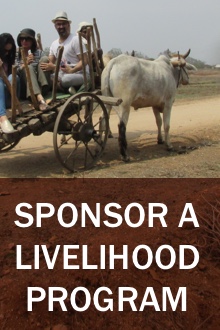What’s causing that pollution?: Workshop by Reniscience Education
Everyday, we expel unnatural and harmful elements into our surroundings. In the beginning, they are nothing more than a mere inconvenience, however, over time, we experience the full effects of our actions.
Whether it is littering in our immediate environment, creating a ruckus in the neighbourhood, contaminating our water bodies or simply putting into the atmosphere gases that do no good for us, we pollute in many ways.
This month, the students learnt about the pollution around them in this workshop by Reniscience Education. Sangita Kapadia and Purvi Vora took the students out of the classrooms all around- into the village, by their lake, by the roads- to examine the impact through the pollution created in the village.
Through a pollution survey, the students were meant to identify the greatest sources of pollution and later, come up with solutions to best tackle the issue.

Students in the village of Kohka conducting the pollution survey.
Manipulating the Sun: Workshop by Curiouscity Science Education
One of the best and most effective sources of clean energy, the Sun, has been manipulated to our benefit since time unknown.
Our students are well versed with solar energy through their extensive exposure to the workings of a solar planel. After all, it is a kilo watt of solar that supports their favourite classroom.
However, this month we took manipulating solar energy a step further with this workshop by Curiouscity Science education. Educators, Utpal Chattopadhyay and Shonali Chinniah, taught the children what happens when we mix different materials, natural and artificial, colours and the light from the Sun.

Utpal and Shonali explaining the potential of solar energy to the students.
Journey to the Centre of the Earth: Workshop by Reniscience Education
While the 1864 novel introduced to children a completely spectacular image of the underground and of what the Earth is made up of, the reality is quite different. However, it isn’t of importance that the Earth’s core isn’t as exciting as that imagined by characters, Alex and Professor Lidenbrock, the Earth’s core is still extraordinary. Off course, one does not expect the same hospitality from the planet like in the science fiction novel.
This month’s agenda compromised of a virtual journey to the centre of the Earth. Our students are aware of what is extant above the Earth’s surface, but this workshop took them below it to discover what lies beneath.
Purvi Vora and Sangita Kapadia of Reniscience Education made this workshop just as entertaining as the far fetched novel with some fantastic activities.

The wonderful duo of Reniscience Education introducing the concept of the Earth as an onion consisting of various layers.
When self expression meets fun!: Workshop by Vikram Sridhar
This month, we had a unique workshop by a very unique personality, Vikram Sridhar. Vikram is a Performance storyteller and theatre practitioner who uses his art and story telling gift to make a difference. Vikram believes the body is a tool of communication. Through his workshops he assists students in becoming more aware of their own bodies and helping them use them as communication tools like he does with his folktale telling performances.

Vikram animated as ever! The students were simply fascinated by his energy and comic movements.
Turning three at the E-Base!
Sometimes, all we need is a little inspiration to give us the thrust in the direction of action. With simply the intention of inspiring on the third anniversary of the E-Base, we had a small celebration to mark three years of educating and motivating to lead change.
This anniversary the students got an opportunity to interact with very dynamic guests- Bhajju Shyam, Vikram Sridhar and the Special Tiger Protection Force (STPF) of the Pench Tiger Reserve, Maharashtra.
The immensely talented and renowned Gond artist Bhajju Shyam wowed the students with the story of his life. Coming from the Pradhan tribe, a sister tribe of the Gond, Bhajju Shyam has seen it all and done it all. From working as a security guard in Bhopal to giving talks in Paris and London; Bhajju ji’s life took a complete 360 degrees turn.

Bhajju Shyam taking the students through his first book: The London Jungle Book. Captivated by the systems and culture of London, Bhajju ji retells each of his experiences with enthusiasm as the students listen and marvel at his Gond depictions of the same in his book.
A Changing World: Workshop on Climate Change by Pooja Choksi
Our planet as it once began has been constantly undergoing changes. The only difference between the changes taking place in the last few centuries and those before that is that now these changes are instigated by man’s actions.
The students know one thing like a gospel truth: life cannot exist without oxygen. It was time to however introduce them to other atmospheric gases playing equally significant roles in the upkeep of our planet.

Students understanding the task at hand. The atmosphere consists of 78 per cent nitrogen, 21 per cent oxygen and 1 per cent of all other gases and water vapour. The students were meant to correctly label the pie chart.
Sava Sher: Identity exploration and Film making with Tuning Fork Films
The Pench Tiger Reserve is home to the famous Royal Bengal Tiger. This large cat has come to receive much attention and conservation efforts focus on the recovery of the numbers of this majestic specie. With the tiger at the fore, changes in the reserve take the form of changing rural landscapes, social fabrics and tourism revolving around the tiger.
Through our identity exploration and film making workshop, we wished to shift focus from the tigers of Pench and see what lies beyond!
Our students, rightly the ‘sava shers’ of Pench, learnt about video shooting, editing, voiceovers and everything that comes with film making. However, this was no ordinary film making workshop; the five days of the workshop entailed digging deeper and exploring the relationship of ‘jungle, mein aur gaav’ and, in the words of Ankit, ‘demystifying the camera’.

Pulkita Parsai taking the students through the identity exploration process.
Unleashing the Actors Inside: Workshop on Performing Arts
Amrita Lalljee, Amba Jhala and Anirudh Nair were down in Pench to conduct a very unique workshop this month. The trio, established names in the field of performing arts, visited our students with the motive of making them have some fun and simultaneously helping them find their voices.
Our students walked into the E-Base, unaware of what we had in store for them for the next three days. The workshop encompassed all kinds of learning and fun, from laughing out loud to performing skits based on personal experiences.
Performing Arts is strongly linked to building one’s confidence and opening up. Our aim is to help our students not only find their voice to make them confident community leaders but also identify performing arts as a strong medium of expression and raising awareness.

Our students in an exercise that involved laughing their hearts out! Yes, it works wonders to them open up.
E-Base Library: This Show is on the Road!

Students on their way into the E-Base for the E-Base library inauguration.
In May, we began a small crowd funding project for Rs. 70,000 for one library in the E-Base in Pench, Madhya Pradesh. Little did we know we would end up raising more than double the amount we had earlier planned to, and build two libraries instead of just one! It is October now and both our libraries together have close to 1200 books, a reading program for members from five schools and two mobile libraries.
The Ubiquitous Life Giver: Workshop on Water by Pooja Choksi
Bill Bryson elucidates the significance of water through a lovely chapter, ‘The Bounding Main’, in his book A Short History of Nearly Everything. To illustrate just why Water is such an important component of our curriculum, we’d like to quote his rather rather colourful lines on water. He says, “Water is everywhere. A potato is 80 per cent water. a cow 74 per cent, a bacterium 75 per cent. a tomato, at 95 per cent is little but water. Even humans are 65 per cent water, making us more liquid than solid by a margin of almost two to one. Water is strange stuff. It is formless and transparent, and yet we long to be beside it. It has no taste and yet we love the taste of it. We will travel great distances and pay small fortunes to see it in sunshine. And even though we know it’s dangerous and drowns tens and thousands of people every year, we can’t wait to frolic in it. ”
The last week of September saw the students of Pench, Maharashtra getting up close and personal with water. They got right into its chemical composition to its behaviour.
With a quick introduction to the chemistry and physics of water, the students studied the water cycle that makes water just so unique. We had a little fun challenging some of the students to try water that had condensed from the use of dirty, inky water (Yes, like we are sure you have guessed, there were no volunteers, it was down to Pooja to drink it).

Students unwilling ot have the water condensed in the ‘water cycle’ bowl.(Image: Monica Szczupider)

